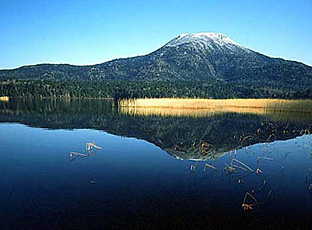
Travel Guide
Introduction
 As a part of the Akan National Park, Lake Akan is a lake of mystery and beauty. It is one of the most renowned sightseeing sites in with its awe-inspiring landscape. The bottom of Lake Akan is inhabited by miraculous marimo, cladophora ball in English, which is a curious looking species of algaes that grow into large green balls.
As a part of the Akan National Park, Lake Akan is a lake of mystery and beauty. It is one of the most renowned sightseeing sites in with its awe-inspiring landscape. The bottom of Lake Akan is inhabited by miraculous marimo, cladophora ball in English, which is a curious looking species of algaes that grow into large green balls.
Originally Lake Akan is a beautiful caldera lake which was formed by the erruption of active Mount Me-Akan volcano (1,499 m) located southwest of current Lake Akan some 6,000 years ago. Ten thousand years ago, Mount O-Akan volcano (1,370 m) located east of the current lake erruped, then the old lake was divided. So around Mt. O-Akan, there are Lake Akan, Lake Panketou, Lake Penketou and a few small lake. The lake used to have a clarity of 8 to 9 meters in the 1930s. Pollution from local hotspring resorts has decreased the transparency to 3 to 4 meters.
The Akan National Park includes a group of volcanoes, such as Mt. Meakan-dake, Mt. Oakan-dake and Mt. Akan-Fuji, so as Lake Kussharo and Lake Mashu. Since the park is situated inland, the temperature fluctuates rather sharply between daytime and morning or night. This phenomenon often produces a sea of beautiful clouds, glittery stardust and amazing winter soft rime.
Surrounding area
There is a hot spring town called Lake Akan Hot Spring to the south of Lake Akan and this is the only town around the lake. This resort town dating back to 1908 features over 80 souvenir shops selling native handicrafts from throughout Hokkaido. The town has several ryokan, some of which have hot spring baths with views of the lake on their upper floors. Several hotels open their baths to non-guests during the day for typically 500 to 1,500 yen. From here tourists can experience sightseeing boat cruises which takes 85 minutes to see around the natural environment in Akan from April to November. The boat also goes to Churui island where a Marimo exhibition and observation center is. The best way to see the marimo is to go on the boat tours that goes to the Marimo exhibition and observation center. Other choices include night cruise (only weekend of June through September) and speed boat.
At the western end of the town, there is a Ainu village called Ainu Kotan, which is biggest in Hokkaido. About 200 Ainus are living, and there are the shops selling folk crafts of Ainu. In a theater of the village we can see the dance of Ainu, and we can learn the living and culture of Ainu at a small museum.
At the town's eastern end, walking trails lead through the forest and along the lake to bubbling mud pools known as Bokke. Boiled water and volcanic gas are emitting from the mud of the lake. This 1,500m nature path starting from the Lakeside Eco Museum Centre takes you through forest to the shore of Lake Akan. Throughout the walk keep a look out for squirrels, various species of birds and other wildlife.
Akan Lakeside Eco Museum Centre tells the story of the ecology of flora and fauna (including marimo) found in the Akan district. Illustrated by videos, slides, aerial photos and various literature, the centre offers a great insight to the history and formation of scenic Akan.
Two mountains near Lake Akan compliment the scenery and offer some longer hiking courses. Oakan (Male Mountain) and Meakan (Female Mountain) are both volcanoes whose eruptions formed the landscape around Lake Akan. Meakan remains active and frequently emits sulphuric fumes. Hikers should check with the tourist information center for volcano conditions.
Meakan's two trailheads are located on the west side of the mountain. Hikers usually depart from one trailhead and return via the other trail. Oakan has just one trail that starts from the eastern end of Lake Akan. Hiking either mountain takes about half a day. They are not difficult hikes, although sturdy hiking shoes are recommended. The mountain trails are passable between June and October. Outside of these dates, they are likely to be buried under snow.
Travel Advice
Sightseeing
You can experience sightseeing boat cruises to see around the natural environment in Akan. Other choices include night cruise and speed boat. Please see the details at English official site of Akan Sightseeing Cruise Company.
The Legend of Marimo
There once was a daughter of a chief of an important tribe living on the banks of Lake Akan, who fell in love with a commoner. Their relationship met with the opposition of her parents. In order to be together, they ran away, metamorphosed into Marimo and lived happily ever after. Because of this myth, the Marimo has become known as the love plant in Japan.
About Marimo
 Marimo literally means seaweed ball. It is a species of filamentous green algae that grow into large green balls with a velvet like appearance, also known as cladophora ball, lake ball, and, in some cases moss balls.
Marimo literally means seaweed ball. It is a species of filamentous green algae that grow into large green balls with a velvet like appearance, also known as cladophora ball, lake ball, and, in some cases moss balls.
Although marimo and its related species are observed in the lakes of several European countries and in some other lakes in Japan, only in Lake Akan marimo grow 20 to 30 centimeters (8 to 12 inches) in diameter and have a spherical surface that is beautifully soft and smooth like velvet. Left alone for a few centuries, marimo can reach the size of soccer balls. The algae have been designated a National Special Natural Monument.
A marimo is sometimes mistaken for an animal in the aquarium because of its movement, which is another reason for the interest. Furthermore, it has a rather long life span. The largest Marimo ball is known to have lived for over 100 years. So by cultivating the algae balls under the right conditions, you could lovingly pass down a Marimo through a couple of generations, from grandparents to a grandson.
Marimo have not always had an easy life in the lake which serves the local community as a tourist attraction and a valuable water resource. Ironically, after the first governmental designation of marimo as a Natural Treasure in 1921, people came from all over the country to obtain these unique plants. Some were taken away as souvenirs by tourists and many others were stolen and sold for high prices in urban areas. Other damages were caused after a hydroelectric power plant was built along Akan River which flows out of the lake in 1920. A number of marimo, which can survive only in the shallow water, were exposed and withered as a result of the lowered water level due to the use of lake water for generating electricity.
In the 1940s, recognizing that marimo was severely endangered, the local people launched a campaign to protect the plant, one of which continues to this day, the Marimo Festival which originated in 1950. Held every October, when the autumn leaves on the lakeshores are at their best, the three-day festival is led by the local Ainu people, and culminates on the third day with a ritual in which a senior Ainu on board a small wooden boat returns the marimo one by one, carefully and thankfully, into the lake.
The local government of Akan Town re-opened the Marimo exhibition and observation center in 1996 after extensive renovation. The new center is equipped with various facilities to promote the environmental and scientific importance of marimo as well as research on the protection and propagation of the species.
Autumn Leaves
Lake Akan is a spot to see autumn leaves. Please see Autum Leaves in Lake Akan.
Events
| Events in 2019 | ||
| Lake Akan Marimo Festival | The festival is led by the local Ainu people, and culminates on the third day with a ritual in which a senior Ainu on board a small wooden boat returns the marimo one by one, carefully and thankfully, into the lake. | Oct 8(Tue) to 10(Thu) |
| Thousand Torch Festival | It is an Ainu traditional event to thank the Fire of God and the northern earth. During the event, you can parade from hot spring town to Ainu Kotan holding the torch every night. | Nov 11(Mon) to Dec 7(Sat) |
| Events in 2020 | ||
| Lake Akan Ice Festival | Lake Akan will be turned into a stage for winter festivities. There will be ice sculpture exhibition and a small ceremony every night. The fireworks display will be presented under the clear night sky too. | Feb 1(Sat) to Mar 2(Mon) |
| Iomante Fire Festival Summer Version | Gathering around a bonfire, Ainu people dance and sing to pray for peace and visitors’ health with Ainu ceremonial dress as they did in the ancient time. | Mar 18(Wed) to Nov 30(Mon) |
| Lake Akan Open Festival | The activity includes the lottery for a free ticket for cursing, orchestra performance by students and the taste of local fish of Lake Akan such as rainbow trout. | Apr 29(Wed) |
Visit
| Address | Kushiro-shi, Hokkaido | |
| Phone | 0154-67-3200(Akan Tourist Assosiation) | |
| Admission | Free | |
| Hours | Free time | |
| Closed | Open 7 Days a Week | |
| Duration | 30 minutes | |
| Getting There | By Train 2 hours ride by Akan Bus bound for Lake Akan Bus Terminal from JR Kushiro Station to the final stop, then walk approximately 5 minute. By Car Take Doto Expressway to Ashoro exit and take National Highway route 241. It is approximately 70 kilometers 70 minutes from exit. |
|
| Parking | Parking available | |

